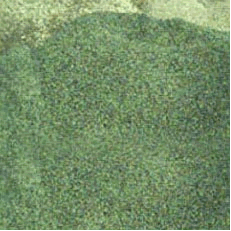Formula MnO Melting point 1,945 °C Boiling point 3,127 °C | Molar mass 70.9374 g/mol Density 5.37 g/cm³ Appearance green crystals or powder | |
 | ||
Manganese(II) oxide (systematically named manganese(2+) oxide(2−)) is an inorganic compound with chemical formula MnO. It forms green crystals. The compound is produced on a large scale as a component of fertilizers and food additives.
Contents
Structure, stoichiometry, reactivity
Like many monoxides, MnO adopts the rock salt structure, where cations and anions are both octahedrally coordinated. Also like many oxides, manganese(II) oxide is often nonstoichiometric: its composition can vary from MnO to MnO1.045.
Below 118 K MnO is antiferromagnetic. MnO has the distinction of being one of the first compounds to have its magnetic structure determined by neutron diffraction, the report appearing in 1951. This study showed that the Mn2+ ions form a face centered cubic magnetic sub-lattice where there are ferromagnetically coupled sheets that are anti-parallel with adjacent sheets.
Manganese(II) oxide undergoes the chemical reactions typical of an ionic oxide. Upon treatment with acids, it converts to the corresponding manganese(II) salt and water. Oxidation of manganese(II) oxide gives manganese(III) oxide.
Preparation and occurrence
MnO occurs in nature as the rare mineral manganosite.
Commercially it is prepared by reduction of MnO2 with hydrogen, carbon monoxide or methane, e.g.:
MnO can also be prepared by decarbonation of the carbonate:
MnCO3 → MnO + CO2This calcining process is conducted anaerobically to prevent formation of Mn2O3.
An alternative route, mostly for demonstration purposes, is the oxalate method, also applicable to the synthesis of ferrous oxide and stannous oxide. Upon heating in an oxygen-free atmosphere (usually CO2), manganese(II) oxalate decomposes into MnO:
MnC2O4·2H2O → MnO + CO2 + CO + 2 H2OApplications
Together with manganese sulfate, MnO is a component of fertilizers and food additives. Many thousands of tons are consumed annually for this purpose. Other uses include: a catalyst in the manufacture of allyl alcohol, ceramics, paints, colored glass, bleaching tallow and textile printing.
